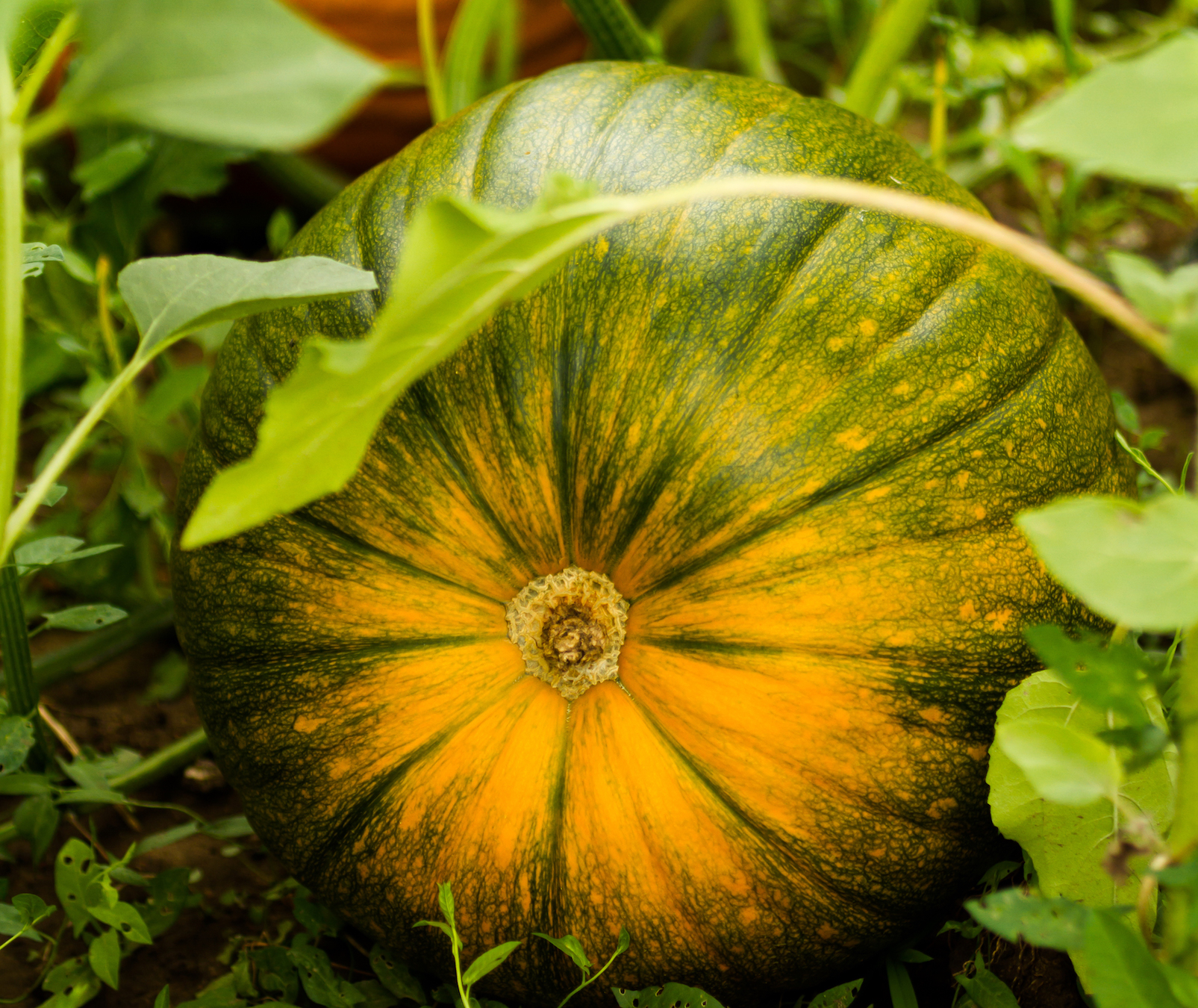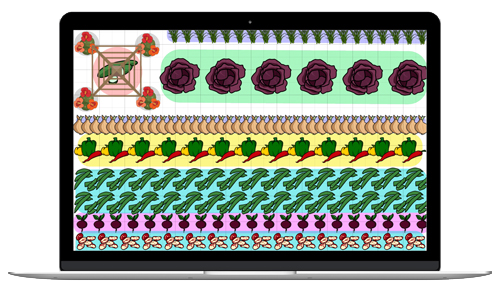
From spooky jack-o'-lanterns to homemade pies, learn how to plant, grow, and store pumpkins
The Almanac Garden Planner - Use It Free for 7 Days!
Plan your 2025 garden with our award-winning Garden Planner.
Types
Every pumpkin has a best purpose. When choosing a pumpkin, think about what you want to do with it. All pumpkins are technically edible, but ornamentals are better for carving, and other pumpkins are best for cooking.
Miniature Pumpkins
Miniature pumpkins are very productive and easy to grow, sometimes producing up to a dozen fruits per plant.
- ‘Jack Be Little’, a miniature variety, is dual purpose. Store-bought shiny (painted) ones make an ideal decoration for a holiday table. Remove the seeds from farm- or homegrown specimens and then bake them for a tiny treat. Vine variety. Days to maturity: 90 to 100.
- ‘We-B-Little’ is an All-America Selection winner, and ‘Munchkin’ is another great miniature pumpkin.
Pumpkins for Carving
- ‘Autumn Gold’ is great for carving and decorating. All-America Selection winner. Vine variety. Excellent for jack-o’-lanterns. Days to maturity are generally 100 to 120.
- The larger ‘Magic Lantern’ and ‘Merlin’ are great for carving and decorating.
Giant Pumpkins
- ‘Dill’s Atlantic Giant’ jumbo variety can grow to 200 pounds. Great for those who want to grow a ginormous pumpkin. Vines will spread to 25 feet, so space is a must. Days to maturity are 130 to 160, so plant early! Thin to the best one or two plants. Feed heavily but keep cultivation shallow. Remove the first two or three female flowers after the plants start to bloom so that the plants grow larger with more leaf surface before setting fruit. Allow a single fruit to develop and pick off all female flowers that develop after this fruit has set on the plant. Take care that the vine doesn’t root down near the joints to avoid breakage.
- ‘Big Max’, ‘Big Moon’, ‘Jack O’ Lantern’, and ‘Funny Face’ are some of the best giant pumpkins for carving.
Perfect Pumpkins for Pies
- ‘Sugar Treat’ is excellent for cooking and baking. Days to maturity are generally 100 to 120. ‘Hijinks’ and ‘Baby Bear’ are both All-America Selection winners and have sweet flesh for pumpkin pie.
- ‘Cinderella’s Carriage’ is also perfect for pies or soups.
- ‘Peanut Pumpkin’ also produces very sweet flesh and can be great in pumpkin pie or pumpkin puree.

Colorful Decorative Pumpkins
- ‘Jarrahdale’ has blue-green skin and makes for great decorations.
- ‘Pepitas Pumpkin’ is orange and green.
- ‘Super Moon’ is a large white pumpkin.
Cooking Notes
- See how to clean a pumpkin for cooking.
- Don’t forget about the seeds! Roast them with salt or cinnamon for a tasty treat.
ADVERTISEMENT
We grow pumpkins in England, mainly for carving (grandchildren love them) to cooking. Your advice about mulching has been taken on board and our grass clippings are being used, the runners will be cut to allow three per runner. I have also mounded soil over the runners in the hope they put down more roots. Have you tried pumpkin curry? We will make one when ours are ripe. Cheers Alan and Cath in Crewe England.
My plants are already coming out and the vines are coming. I am going to set up a sprinkler system,but what I am wondering is I can place the sprinklers so it justs comes out with a light spray. How far out of the ground should I leave them and can I place it right between the 2 plants that are practically next to each other or should I place it further away. I am trying to avoid getting the leaves wet as much as possible but I know that is hard to do. In between the mounds I can place one that can keep the soil wet for the vines. I am inexperienced but I am trying to learn by trial by error. Also, one other question. On on of the mounds I placed 4 and they are fairly close together. I never weeded it out. WOuld it be best for me to get rid of one or 2 of them. Thanks for your time
About thinning: thin to 2 to 3 plants per hill by snipping off unwanted plants without disturbing the roots of the remaining ones. Do this before you do anything else. And weed. Once the plants spread vines there should be far weeds. And mulch.
Drip irrigation is a slow, fairly steady release of water that gets to plant roots. Aim to replicate that with water of one inch per week, more during fruit set.
Water is important but read the “Pump Up Your Pumpkins” advice above; fertilizer is also going to improve your chances for a hefty harvest.
So I have a huge pumpkin vine growing I went out about a week ago the root was dug up and ripped out. I saved it (had just set second root week before, saved me full loss) but it's hurt.
I go out this morning, my Thai pepper is ripped up, the huge pumpkin root (but not root area), we've sighted skunks in the neighbor hood, are they digging for Pill bugs in my roots (which i have an infestation of) or something else? How do I fix this, by removing the food source (killing whatever they're eating)?
Hi David,
We’re sorry to hear of your garden troubles! It sounds like it could be a skunk doing the digging, though it could also be a raccoon or a couple of squirrels. Getting rid of the pill bugs might stop the animal from coming around; spread diatomaceous earth around plants and throughout the garden to reduce the number of pill bugs. Also, try putting up a short fence—2 to 3 feet high—and see what happens. Skunks can climb fences, but they usually choose not to.
I live in Philadelphia PA. We have a pumpkin vine that is growing amazingly. But we just returned from a 5 day holiday and the base of the vine has darkened and the base leaves are a bit yellow. I'm hoping this is just the vine "hardening". We have an irrigation system that waters the garden for 15 min in the morning and evening. If we need to bump up the watering we can, seems like I need to snip some vine tips (per other advice), but any other insight you can provide would be really helpful. We have raised beds. Base of vine is in partial shade, but majority of vine is predominately full sun. Thanks in advance!
Yellowing leaves at the bottom of the plant (the older leaves) sometimes mean an iron deficiency. Pumpkins are big feeders so perhaps they at a lot when you were gone and you need to feed them some more! We’re not sure what you mean by the vine “darkening.” As the pumpkin reaches maturity, the vine is more likely to turn yellow. If the leaves start to wilt, look at the base of the plant and ensure you don’t have the squash vine borer. See more about identification and control: http://www.almanac.com/pest/squash-vine-borer
I've got about 15 plants; n a 3'x3' planter here in my So.California yardyard and they're all already a foot talltall each. What should I do about the area they each need for growth? I have room for the vines, to sprawl outout just don't know about them having room between each other...? -im Clueless but wanting to learn!
The spacing will depend on the type of pumpkin you are growing. (The 15 plants are all pumpkins, right?) Ideally, follow the suggestions on the seed packet or transplant. In general, mini pumpkins may need about 1.5 to 3 feet between each after thinning, while standard pumpkins need about 3 to 5 feet. In a planter, the giant type of pumpkin likely wouldn’t be appropriate. For standard types in a 3x3 bed, thin out your 15 pumpkin plants to just 1 or 2, snipping the stems off at the soil surface, so as not to disturb the roots of the plant(s) you’d like to keep. For mini pumpkins, you might be able to keep 2 or 3 plants. (For pumpkins, it’s better to have a deeper container, such as 2 to 3 feet deep, if possible.) Good luck!
Hoping someone can help me as I have scoured the internet and fpund very little information about my issue with my small sugar pumpkin plants. Grew them last year and the vines got very long and were very healthy, but I never once saw a female flower on any of them, only the males, so obviously I didn't get any fruit either! Anything I can do this year to encourage growth of the female flowers? They were in ground in full sun, sharing the same patch as my cucumbers. Thanks!










